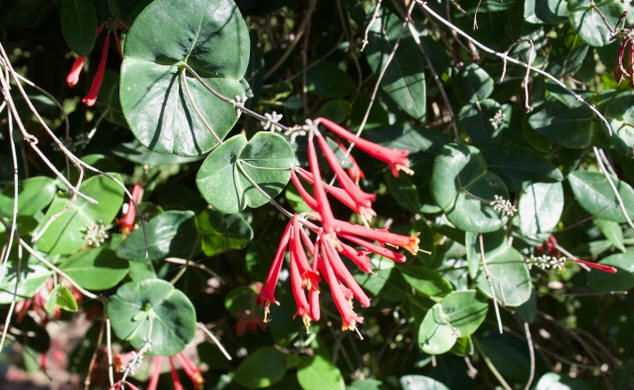Barbara Mrgich
Adams County Master Gardener
Would you like to add some height to your garden, or hide an undesirable view quickly? Honeysuckle is your answer. Just be sure it is a native honeysuckle, Lonicera sempervirens. Japanese honeysuckle, (Lonicera Japonica ) is highly invasive and considered a noxious weed because it displaces native plant species by growing rapidly and outcompeting them for light, space, water and nutrients.

About five years ago, we were forced to remove a very large Leyland Cypress from our front border. It left a surprisingly huge area of our yard exposed to the neighbors. I wanted to add some instant privacy, and considered some different shrubs and trees, but I knew they could take several years before they filled out to achieve the desired effect. I finally hit on the idea of honeysuckle on trellises. I asked our local handyman to make me two trellises. They are very sturdy, made out of 2 X 4’s with 1 X 1’s as the cross sections. The above ground parts are seven feet tall and four feet wide. We used a post hole digger to set them in the ground, and they easily support a large, heavy vine.
I then bought two Lonicera sempervirens ‘Major Wheeler’ and it has been a love affair ever since. They were small plants when I bought them in the spring, but they grew surprisingly quickly. They covered those trellises in the first couple months. ‘Major Wheeler’ starts to bloom in mid-May, and keeps pumping out the flowers until after frost. It’s hard to look at it for too long and not see a hummingbird. Although it is deciduous (loses its leaves), it maintains its presence throughout the winter because it is not herbaceous. In other words, it does not die to the ground. It sure did add that element of privacy to the yard that I was looking for.
To finish my project, I added several Oakleaf Hydrangeas in front of the trellises, and it makes a very attractive corner in our front yard. In retrospect, I could have used slightly smaller shrubs. Oak leafs are large shrubs and they do hide a lot of Major Wheeler. George Weigel, my favorite garden writer, recommends the cream, green and burgundy foliage of Abelia ‘Kaleidoscope’ (which is a smaller shrub), fronted by some yellow annuals to compliment the coral red color of the honeysuckle.
‘Major Wheeler’ is called a trumpet honeysuckle and hummingbirds love to put their long tongue into that tubular flower to find the sweet nectar waiting at the bottom. I love the unusual leaf arrangement of the native honeysuckle. The flower stem seems to grow right through the center of the leaf.
There are other honeysuckles that are not invasive that are considered garden worthy. For many years, I had a honeysuckle called Lonicera x heckrottii 'Gold-flame'. It had a beautiful two-toned flower, but for all those years, it would be-come covered with an ugly fungal disease for most of the summer. Since I, personally, don’t believe in using chemicals in my gardens, I finally dug it out and replaced it with another native Lonicera sempervirins ‘Magnifica’, which also promised to bloom "from early summer to early fall".
The first year in the ground, it flowered beautifully through May, then quit for the rest of the summer. I was very disappointed! However, two years later, it has continued to produce flowers all summer as promised. This year, it was still attracting hummingbirds regularly in September.
I have never yet seen a hint of mildew on either ‘Major Wheeler’ or ‘Magnifica’, and ‘Magnifica’ is planted in the same hole on the same spot as the sickly ‘Gold Flame’.
When I was a child, and lived on a farm, we had a large patch of honeysuckle that grew on a stone wall beside the springhouse. We kids would sit out there, take a flower, bite off the end, and suck out the sweet nectar. It never occurred to me before I did a little research for this article that that is exactly how lonicera sempervirens got its common name — honeysuckle. The flower needs to be "suckled" in order to get the nectar.
Read other articles on ecological gardening & native plants